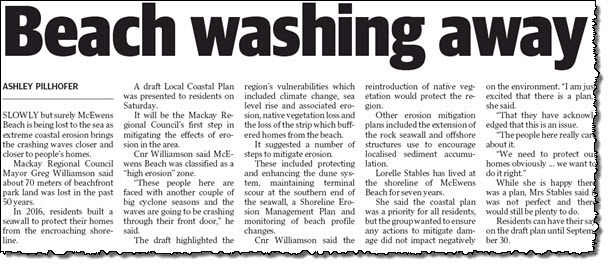
This is part two of Australia’s Collapsing Coast. Read part one here
The crisis of Australia’s collapsing beaches has myriad impacts. Every state is seeing infrastructure, homes, development plans and in some cases entire communities under threat.
Inverloch, Victoria
At Inverloch, south east of Melbourne, erosion has sheared off 50 metres of beach and shoreline in just seven years — including 20 metres since January, 2019. The most immediate point of danger is the local surf lifesaving club.


The councils have trucked in sand and deployed a “wet” sand fence for protection, but this tactic has failed. The Bass Coast Shire Council has made it clear that, beyond the normal level of erosion, it believes the extent of this change is due in part to climate change and rising seas.
Two Rocks, Western Australia
Home to the kitsch of the abandoned Atlantis Marine Park, Two Rocks sits roughly 60km north of Perth. Within 100 years, erosion is expected to have spread a further 170 metres. This will threaten, among other things, development in the area. A group of developers planned to use 834 hectares of dune vegetation for a huge residential estate with 12,000 homes.


Experts argued this would harm the health of the vegetation as the coast eroded, thus hastening the erosion. The WA Planning Commission required the developers’ plan to cede enough land to not only allow for what would be underwater but enough to form a new foreshore in 100 years. The developers challenged this decision at the State Administrative Tribunal, which eventually determined the plan hadn’t provided enough of a buffer zone.
McEwens Beach, Queensland
McEwens Beach in northern Queensland has lost 70 metres in roughly 50 years. A draft local coast plan presented in September 2019 highlighted the region’s vulnerabilities: climate change, sea level rise and associated erosion, and the loss of the native vegetation strip which buffered homes from the beach.


“These people here are faced with another couple of big cyclone seasons and the waves are going to be crashing through their front door,” Mayor Greg Williamson told The Daily Mercury at the time.

Williamson and his council are facing similar problems up and down the Mackay region’s 32 beaches. Trees planted near the shore in Bucasia to support the dunes were cut, apparently for a better view.
“What they don’t realise,” Williamson told The New York Times, “is that if these dunes aren’t here, they’re not going to have a house or a view.”
West Beach, South Australia
According to a state government-funded report by the Danish Hydraulic Institute, about 500,000 cubic metres of sand has disappeared from West Beach since the late ’90s. The rate of this loss has accelerated since about 2011.


It is on a kind of life support from its northern neighbour Semaphore South, with hundreds of thousands of cubic metres being carted from one beach to the other. The sand is promptly returned to Semaphore by the tides.
Sand replenishment will cost the state government nearly $50 million over the next four years. It’s “a very temporary solution and expensive to boot” as Victor Gostin, a former University of Adelaide associate professor in geology and sedimentology, told the ABC.
Stockton, New South Wales
Locals in Stockton believe they are, as far as the local council and state government are concerned, a “lost suburb”.


Last September, a section of their beach lost 2.5 metres in sand height in the space of five hours. The town’s only childcare centre had to be closed for fear it would be washed away.
A rally took to the beach to demand action to protect their communities. Protesters planned to spell out SOS (“Save our Stockton”), but too many people showed up and the beach could no longer accommodate them.
Stockton has lost around 70 metres from the beach since 1981 — a rate accelerating all the time — and the seabed has dropped more than seven metres in the last century.
This is not natural erosion of the same kind faced by many beaches. Associate professor Ron Boyd of Newcastle University’s School of Environmental and Life Sciences said that infrastructure — breakwaters and a deep water channel to allow big ships access to the port — has caused Stockton to lose too much sand.
The wave pattern has been disrupted and, as a result, new sand is not being delivered. In the long run, it simply won’t recover.
Stockton also points to an apparent disparity between a response to the problem in regional centres as opposed to cities: West Beach or areas of the Gold Coast can rely on expensive sand replenishment.
“If this was happening in Bondi, it would be fixed in a heartbeat,” Newcastle MP Tim Crakanthorp told the SMH.
The images in this piece are of areas that have experienced serious erosion though in some cases factors such as the tide position or the spread of vegetation on the shore may increase the effect.









You could add Parck Beach at Coff’s Harbour to these. t has to be restocked with sand quite often> A long storm out at sea will erode it to the dune line (at least it still has a dune line). This is another tale in the many of developer’s chicanery and local government stupidity. Even local councils that get it can be overruled bu the developer’s mates in state governments.